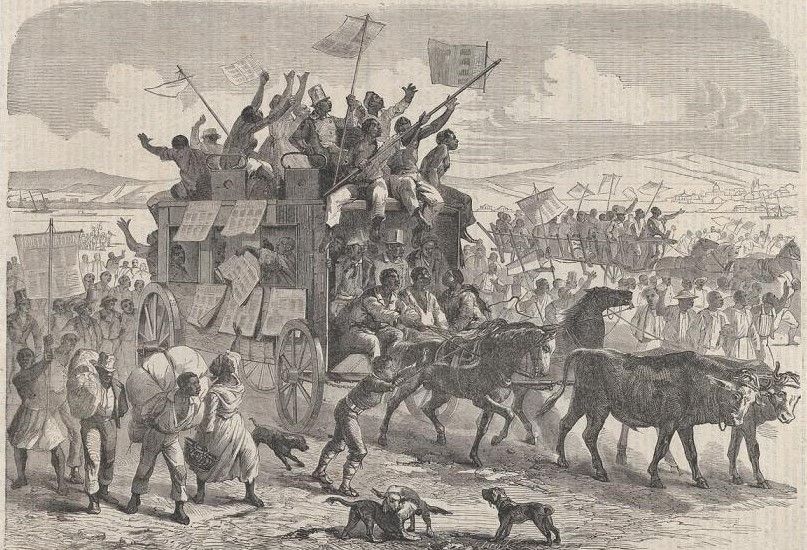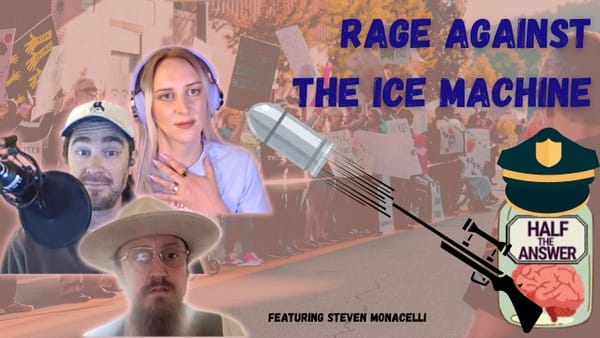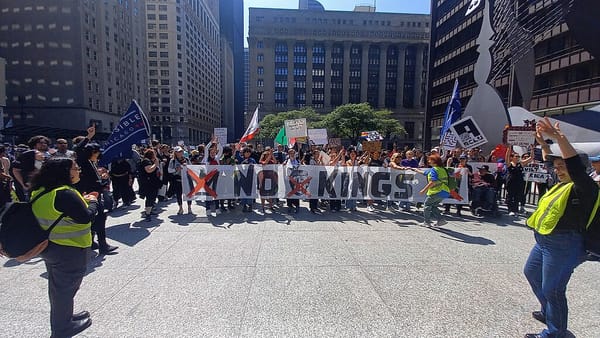The Butcher, the Brewer, the Baker…and the Black Radical

The poor labourer who has the soil and the seasons to struggle with, and who, while he affords the materials for supplying the luxury of all the other members of the common wealth, and bears, as it were, upon his shoulders the whole fabric of human society, seems himself to be pressed down below ground by the weight, and to be buried out of sight in the lowest foundations of the building. In the midst of so much oppressive inequality…
Adam Smith, “Early Draft” of The Wealth of Nations
When the late Charles W. Mills set out to “occupy liberalism,” he did so with two evidently hostile ideologies: Marxism and the Black radical tradition. But, while the occupiers aren’t exactly meant to be greeted as liberators (they too must adapt), the final product is meant to remain distinctively liberal. In outlining “Black radical liberalism” (BRL), Mills takes as the liberal leg of the tripod the ideal theories of the philosophical titans Immanuel Kant and John Rawls. A stronger BRL can be formulated by replacing the ideal theories of Kant and Rawls with the non-ideal philosophy of the Scottish moral theorist Adam Smith and the social liberals that followed in his wake, culminating with the Capabilities Approach. Smith provides the normativity Mills needs for the liberal leg of BRL—and even some of the materialist sociology of the Marxist leg—with fewer wrong turns than Rawls or Kant, but Smith failed to see the abiding patterns of injustice that constitute an “ill-ordered society”.
Black radical liberalism
Each leg of the BRL tripod modifies the others. Liberalism provides the aspirational normative commitments of freedom and equality for all persons, living in stable peace and rising prosperity in a diverse society in which things tend to get better for a random person on the street. But liberalism in practice has failed to live up to its lofty ideals. Mills argues that liberalism needs to onboard a Marxist critique that theorizes social classes, class-based oppression, and a more materialist understanding of how economic forces shape politics and social life.
Liberalism and Marxism both, however, have largely failed in practice to account for racialization. Incorporating insights from the Black radical tradition and critical race theory illuminates how class conflict and exploitation are racialized, and how liberal legal and economic institutions have despite—and because of—ostensible “color-blindness” implicitly assumed Black inferiority and perpetuated Black oppression.
Mills seemed to be a committed liberal in his later years, but he often cited an instrumental reason for engaging with liberalism for Black liberatory ends: liberalism is the dominant game in political philosophy. So it makes sense that Mills chose Rawls, the preeminent liberal philosopher of the 20th century, as his primary interlocutor. To develop BRL, Mills first problematizes Rawls’s ideal theory, with its original position and “veil of ignorance” thought experiment. In Rawls’s veil of ignorance, idealized rational persons are shorn of all information about the place they occupy in society and then set to hammering out principles of justice they could agree to without such personal information. Because no one introduces racial discrimination behind the veil, Rawls’s theory has very little to say about the non-ideal situation of racial inequality that confronts us this side of the veil.
Mills suggests we consider an alternative veil of ignorance, in which rational deliberators retain information about structural racism, but are charged with fashioning principles of corrective justice given the reality of racist oppression and their ignorance of their own placement within the racial hierarchy. For Mills, Rawls’s famous principles of justice—basic liberties, the idea that any inequalities must advantage the worst off, and fair equality of opportunities—would be transformed into vaguer principles of corrective justice for “eliminating illicit white advantage/white privilege/racial pleonexia [greed] in whites’ basic liberties, opportunities, and social respect, in a non-ideal, ill-ordered, white supremacist society.”
Mills was committed to radicalizing contractarian liberalism, but this project involved a curious two-step.
- Begin with the liberal contract of ideal theory.
- Problematize the ideal theory by pointing out implicit white supremacist norms.
- Formalize antiracist principles of corrective justice.
It makes sense from a strategic perspective to engage with Rawls and the massive, still ongoing research program he spun off. But Mills was open to fostering a variety of BRLs. And the de-idealizing two-step can be avoided entirely with alternative liberal traditions. The moral system of sympathy and political system of natural liberty advanced by Adam Smith is an attractive basis for such a project, especially as Smithian insights were further developed in the present day by “capabilities” liberals like Martha Nussbaum, Amartya Sen, and Elizabeth Anderson. Mills obligingly provided a template in the epilogue of Black Rights/White Wrongs for radicalizing a liberal political theory:
- Overarching framework: Non-ideal theory
- Theoretical focus: Ill-ordered societies
- Social ontology: Races in relations of domination/subordination
- Task of social epistemology: Exposing dominant racialized ideologies, whether overt or subtle
- Actual hegemonic variety of liberalism: Racial liberalism
- Normative orientation: Corrective justice
- Key normative tool: Black radical “Kantianism”
- One possible strategy: Adapting Rawls for corrective justice
After a brief summary of relevant Smithian ideas, I’ll proceed to plug Smith into this template.
Smithian liberalism
Smith described a moral system—his Theory of Moral Sentiments—that was constructed from the bottom-up by moral actors observing what actions and feelings earn approval and disapproval from others in their society. We imagine ourselves in the other’s situation and reach for impartiality by reflecting on what an impartial spectator would judge. This “mirror of society” is inherently contextual. This avoids the problems of abstract ethical systems, but it means our moral sense always remains tethered to the social morality around us, however we may stretch our moral sensibilities by seeking out diverse perspectives.
Smith’s political economy is often pithily summed up as the “system of natural liberty” wherein each person is left free to pursue their own self-betterment by their own lights, within the constraints of justice. But equally important for present purposes is Smith’s attention to historical contingency in shaping institutions. Anticipating Marx, Smith viewed political and economic institutions—including property—as functions of the stage of economic development (on Smith’s stadial schema, these were hunter/gatherer, shepherds, agriculture, and commercial society). In addition, Smith saw a large role for governments in provisioning public goods, education, and support for the arts. Smith never missed an opportunity to point out both the unjust privileges of the rich and powerful and the tendency of said elites to jealously guard such privileges. Smith did not develop a concept of distributive justice, but nevertheless evinced a class consciousness that made him favor taxes that undermined privilege where possible, as well as every reform that benefited the worker against the capitalist. Though plainly an egalitarian, Smith was a gradualist rather than a radical, cautioning against abrupt and dramatic change.
Non-ideal theory
Rawls theorized about a nearly perfectly just society with only minor deviations from strict compliance with social rules. As abstract rational deliberators confer behind a veil of ignorance, of course they fail to introduce racist oppression into their principles of justice. But then, as Mills points out at length, whole literatures are spun out about the angels-on-pins minutiae of the principles of justice in raceless worlds and these ideas bleed into applied analysis of our thoroughly unjust, racialized world in ways that offer little understanding and few solutions for oppression.
Mills sees no way forward but rewinding all of ideal theory and starting contractarian liberalism over, largely from scratch. By contrast, Smith is non-ideal from the start. Indeed it is characteristic of the entire Scottish Enlightenment to reject philosophizing from “original position” hypothetical scenarios. We are always already enmeshed in a matrix of norms, relationships, institutions, and expectations. Smith’s sympathetic “mirror to society” impresses upon us that we are continually reconstituting the norms and institutions that shape our lives by fulfilling our expected roles and acting accordingly. Where theorizing from a hypothetical “state of nature” leaves us adrift when confronted with real world values and social patterns that would never have been approved behind a veil of ignorance, a Smithian approach shows us how these patterns are upheld and urges us to investigate their historical origins.
Smith looks to the past and considers how present institutions came to be the way they are. What were the historical contingencies that brought them about? Who were the powerful interest groups, what were their motivations, and who were their allies and adversaries? How did the distribution of power come to be what it is? Consider Smith’s famous account of how the middle nobility lost influence and power relative to both monarchs and bourgeois towns. In the burgeoning commercial society, these landed gentry over time and in the “wantonness of plenty” traded men-at-arms and retinues of servants in exchange for “trinkets and baubles”. On Smith’s account, as this happened monarchs allied with growing commercial towns to centralize their authority, further marginalizing nobles. Right or wrong, this exemplifies the style of Smith’s historical analysis of institutions and power.
Similarly, Black radicalism emphasizes the long history of anti-black racism as it developed out of slavery and adapted to changing social environments. The 1619 Project or Ibram Kendi’s history of ever-evolving racist ideas from the arrival in America of the first African slaves to the present are typical of this approach.
A typical, if grossly oversimplified, summary might go like this: following the end of slavery, attempts by Radical Republicans to redistribute the land of former slave holders to the formerly enslaved failed; Blacks advanced under Reconstruction, but political support for continued use of the military to enforce it evaporated and so it was abandoned, leaving the South to white supremacist rule under the Democratic party; a campaign of lynching and other acts of violent white supremacist terrorism, formal Jim Crow segregation in the South, and redlining and other tools in the rest of the country, crushed any burgeoning Black flourishing until the Civil Rights Movement of the 1960s, after which Black oppression was carried on by the War on Drugs, mass incarceration, and the continued use of restrictive land use laws. Throughout this history, Blacks were largely excluded from government-sponsored wealth transfers like land grants and mortgage subsidies aimed at launching and entrenching a property-owning middle class.
This kind of story about the continual adaptation of white supremacist institutions over centuries leading to an entrenched Black underclass fits with Smith’s historical counterfactual approach to understanding the origins of contemporary social classes and relations as they actually exist and function. The focus on history is critical in antiracist thought because white history obscures antiblack violence and wealth destruction. We can contrast this approach to Rawlsian ideal theorizing from an “original position”. Instead of understanding how things got to be the way they are, we’re told they would be very different had they evolved from Ideal Year Zero. The problem of ideal theory is less that it papers over the imperfections of the real world—though it does—but that so much intellectual energy is spent figuring out what the ideal ought to be and no energy is devoted to understanding why we aren’t even approaching anyone’s ideal. Smith and the main company of Black antiracist intellectuals begin, continue, and end in the real world.
Ill-ordered societies
Mills’s second point of direction for Black-radicalizing liberalism is to ditch the well-ordered society of “complete compliance” with the principles of justice and focus instead on ill-ordered societies characterized by deep, abiding patterns of injustice and oppression. Smith himself did not think of society as deeply unjust. He thought one could fulfill the requirements of justice simply by doing nothing—living one’s life according to a tolerable adherence to everyday morality. But Smith also recognized—and called out—oppressive institutions in his day: notably European imperialism, slavery and the slave trade, and infanticide.
But a liberal can take insights from Smith to more radical ends. Smith had an abiding suspicion of power and inequality, and counseled legislators to be suspicious of capitalists and monopolists who would never fail to conspire against the public. He observed a tendency in people to give the rich and powerful the benefit of the doubt, to sympathize with their (sometimes dubious) struggles while failing to see the objectively weightier trials of the oppressed. And Smith identified a “love of domination” as a natural feature of the human psyche.
Black radicals and antiracists supply the details of how antiblack order manifests and functions, but Smithian liberals can readily understand how such an order is stabilized by the social fact of power and the love of power by those who have it and the mystique power holds over the powerless.
Races in relations of dominance and subordination; exposing racial liberalism
We can put the schema of dominating and subordinated races into Smithian language by noting how the social construct of racial hierarchy is constituted by the social mirror. We see actions that sustain white supremacy earn approval, and those that flout white supremacy earn disapprobation. Indeed this just rephrases Smith’s point about the obsequious attention the poor pay to the powerful. Though Smith is often seen as defending economic inequality, he was both suspicious of the influence that came along with great fortunes and he feared the possibility of an “oppressive inequality” of a few fortunes so vast they could not dissipate by normal means. Black radical liberals might point out the persistence of racial wealth gaps (as well as other gaps in well-being) as a strong analogy to the oppression of extreme wealth inequality. Just as extreme wealth inequality distorts our moral sentiments to sympathize with the rich and scorn the poor, racial inequality—which of course is entwined with wealth inequality—distorts our moral sentiments to sympathize with whites and scorn Blacks and other racialized groups.
Corrective justice
Smith largely predated the move to distributive justice, so there’s little room in Smith for massive redistribution based on legacies of racial injustice where most of the original victims are dead and redistribution must therefore be based on contentious counterfactual calculations. But here it’s worth recalling Smith’s materialist “stadial” view of history. Smith saw social institutions and mores adapting to the mode of production and social organization. Just as the agriculture-centered society gave way to the commercial society made possible by industrialization, the early commercial society Smith knew evolved uniformly throughout the developed world into a late commercial society characterized by a growing bureaucratic state providing social welfare and other public services. A Smithian liberal can and should view this as an apparently natural consequence of maturing commercial society. With the machinery of large-scale redistribution in place, the expectations and mores follow for such redistribution to be equitable.
There is also the possibility of a generous reading of the famous “system of natural liberty” passage where the sovereign is accorded the “duty of protecting, as far as possible, every member of the society from the injustice or oppression of every other member of it, or the duty of establishing an exact administration of justice.” Smith uses the phrase “oppression” liberally throughout his published and unpublished works, often referring to a kind of “vexation” visited upon a person by those with unaccountable authority they have leeway to abuse, whether these are tax collectors, magistrates, masters, or church officials. A modern reader might instinctively add police and judges to this list.
Sometimes “oppression” simply means burdensome, as in the case of oppressive regulations. But still other times oppression refers to a large difference in social or political power, or the abuse made possible by such differentials, as in the case of masters and workers or colonial overseers and the colonized. The Smithian sovereign has a deceptively wide scope of powers at their disposal for protecting all members of society from oppression, not just by the state, but by other members and, presumably, social entities like corporations, agencies, and groups.
For a BRL using Smith, white supremacy obviously already constitutes oppression. But as we’ve seen above, racist oppression can be translated into Smithian terms. And on an expansive conception of the system of natural liberty, the sovereign is charged with protecting every person from racist oppression, up to and including corrective justice to end oppressive racist inequality. Affirmative action to racially desegregate public spaces and public offices (as advocated by Elizabeth Anderson) and reparations for slavery and the rolling institutional assaults on Black flourishing and wealth creation (as described by William Darity and A. Kirsten Mullen) are corrective policies that seem well within the scope of a Black-radicalized Smithian sovereign.
A note on Black feminism
One feature of Smithian thought that leans hard against radicalism is his strong inclination against abrupt social change and his warning against “the man of system” who thinks he can move social actors into the preferred positions like pieces on a chessboard. But, as noted, in his own time Smith offered radical diagnoses of unjust but entrenched practices like slavery and colonialism, even if he failed to demand immediate abolition at every opportunity. I’d like to suggest some resonances Smith has with Black feminism, which is itself an indispensable pillar of BRL.
At least one current in the Black feminist tradition can be characterized by radical diagnosis aimed at expanding the political imagination coupled with pragmatic, coalitional democratic politics and an emphasis on harm reduction (negatively) or a politics of care (positively). Black feminists frequently embrace radical causes like police and prison abolition that spook white moderates to no end, but on close examination Black feminists rarely expect—or demand—immediate holistic change.
The point of prison abolition, for example, is to sharply turn away from thinking about incarceration as a normal or expected policy. Angela Davis, in Are Prisons Obsolete? asks her readers to imagine what we would do if prisons were off the table. Black feminists engage in pragmatic politics rather than cosplaying revolution or indulging in democratic political abstinence because they’re sensitive to the fact that those persons living at the margins and intersections of society are the ones most likely to suffer from political instability or antidemocratic government. They take a margin-to-center approach—centering the concerns of Black women, trans people of color, disabled persons, and other vulnerable people—because otherwise such persons are ignored by dominant group politics.
Smith feared political instability. But Smith’s method of sympathy invites us to stretch ever outward and learn in a context-sensitive manner about the diversity of the human experience, pro-actively reaching out to the margins. Smith of course never achieved anything like a feminist consciousness himself. He showed no hint of a non-patriarchal notion of gender roles. Nevertheless, with his suspicion of power, thorough egalitarianism, and attention to the plight of the disadvantaged, Smith held the rudiments of the Black feminist approach to politics.
Smith’s apparent bourgeois antiradicalism seems like an impediment to appropriating Smith for BRL. Smith’s pragmatism is closer to the pragmatism of Black feminism than it is to the anxious centrism of the white moderate.
Black radical capabilities
The “key normative tool” of Black radical liberalism should not be Black radical Kantianism or Rawlsianism, but a Black-radicalized Smithian liberalism. But Adam Smith died over 200 years ago and it would be dubious to tie a live radical movement to a philosophical corpse. Arguably, the closest philosophical heirs of Smith today are liberals of the Capabilities Approach, developed by philosopher Martha Nussbaum and economist-philosopher Amartya Sen. Nussbaum explores this connection in The Cosmopolitan Tradition,
“[…] Smith does not interpret the ideas of justice and respect as narrowly as do Cicero and the Stoics. He sees that a life worthy of human dignity requires more than the absence of aggression, torture, and theft. It requires, as well, certain conditions of labor, because it is in the sphere of labor that a person’s humanity is deeply and fundamentally expressed. The freedom to contract for one’s own labor, the freedom of movement, and the free choice of occupation are all essential to a life in which one can “barter and exchange” like a human, rather than fawning like an animal. Moreover, a life worthy of human dignity also requires the wherewithal to raise a family and bring up children to adulthood, thus a decent living wage; spaces for rest and recreation; and a political life in which laws are made for the good of all, not by pressure of the rich on a captive legislature. Unlike the Stoics, who asked for decent treatment of slaves while holding that the institution itself was a matter of indifference, Smith sees that institutions matter for a life worthy of human dignity and that slavery, colonial domination, and certain forms of domination by the rich over the poor are violations of basic justice. Smith’s argument thus strikingly anticipates similar arguments made by proponents of the Capabilities Approach today.”
Smith, moreover, charges the sovereign with providing institutions to develop human capabilities, as with public education to prevent minds from being “mutilated and deformed” in the division of labor of commercial society. A deeper connection to the Capabilities Approach is found in Smith’s social constructivism. Smith allows that a person deserves to be able to appear in public without shame, and that this requires not just some minimum equipage, but that the requirements vary from one culture to another, indeed are socially constituted. Smith’s example is a linen shirt, without which a “creditable day-labourer” could not appear in public without shame. For capabilities liberals, the plural goods and freedoms required for a life of “truly human dignity” are always understood in their social realization.
Capabilities liberals already typically see race as socially constructed. At least in principle, capabilities liberals are already open to seeing how race as a set of social relations can shape and limit the realizable freedom and agency of individuals. A Black radical capabilities liberal—informed by the Black radical tradition, critical race theory, and Black feminism—would focus on how race interacts with class, gender, and other social forces to shape capabilities. A capabilities BRL analyzes comprehensive social and economic outcomes to advocate for corrective policies. The goal is full relational equality, so that a person’s race neither constrains nor advances their freedom to do and to be what they might have reason to value. This may take various forms, but the stratification economics of William Darity and Darrick Hamilton, which “investigate[s] structural and contextual factors that preserve the relative status of dominant groups via intergenerational resource transfers and exclusionary practices” is one example with an acknowledged influence from the capabilities approach. The political philosophy of the Movement for Black Lives—as described here by Deva Woodly—is another.
Conclusion
In 2018, after reading Charles Mills’s Black Rights/White Wrongs, I emailed the good professor, asking him what he thought of the possibility of a “Black radical capabilities”. He sent me a remarkably indulgent, encouraging response to an amateur’s question:
Dear Paul: That’s a very interesting idea. As you know, my line of argument is that the case for corrective justice needs to be developed as a competitor with the currently predominantly distributivist conceptions, since in theory it should be found less objectionable by people on the right-hand side of the political spectrum. I hadn’t thought of recruiting capabilities theory as a potential resource. But maybe you’re right, that one could seek to articulate a corrective capabilities theory that highlighted the differential and disadvantaging contexts that for some people undermine even their socially recognized personhood. (And in this respect put forward a more minimalist list less likely to provoke controversy.) An idea whose time has come…?
Best,
Charles Mills
6 March 2018
I’ve had this essay in mind ever since then, and I regret that I will not be able to with great trepidation ask Mills if he might—if it’s not very much trouble—read my expanded thoughts on an old email exchange.
Black radical capabilities as I see it is not more minimalist, and it’s unlikely to attract those on the right-hand side of the political spectrum. Yet Smith is beloved of right-leaning liberals, even if they emphasize rather different features of Smith’s thought than I do. Classical liberals might indulge their curiosity about what some ambitious social liberals claim to see in his system of natural liberty. Classical liberals might at least appreciate the possibility that the firmly liberal capabilities approach may make Marx redundant in BRL.
As a sociological thinker, like other protoliberals of the Scottish Enlightenment, Smith launched a liberal tradition distinct from deontology and the social contract, including such diverse and disagreeing liberals as John Stuart Mill, John Dewey, Friedrich Hayek, and contemporaries like Elizabeth Anderson and Jacob Levy. Smith is already non-ideal, already fully in this world and not stuck with one foot behind a veil. A Smithian version of Black radical liberalism is thus far more appealing to liberals of this strain.
The point of Black radical liberalism is to unlock the radical potential of liberalism and to translate Black radical demands into liberal terms. I offer Smith and the capabilities approach as a powerful alternative to Kant, Rawls, and the social contract for doing the liberal work of BRL. When it comes to radicalizing liberalism—I think Mills would agree—let a thousand flowers bloom.




